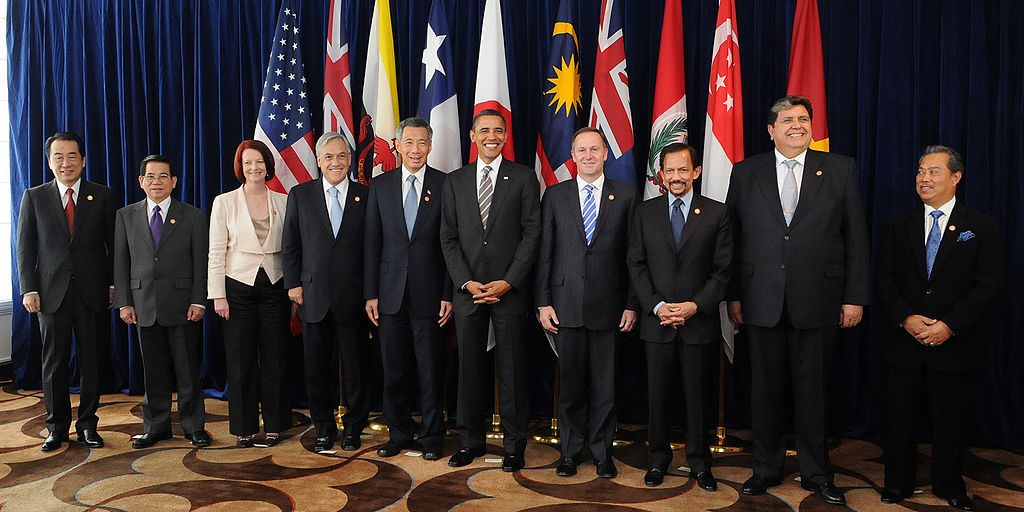
The original TPP group
In a stunning reversal, President Trump announced that he had directed Secretary Steven Mnuchin and US Trade Representative Robert Lighthizer to look into rejoining the Trans-Pacific Partnership (TPP). In an interview with CNBC, President Trump stressed that the US will only consider rejoining the pact when its terms for doing so are “substantially better”.
Countries like Australia, Japan and New Zealand offer a cautious welcome at best. According to the Washington Post, the Australian Trade Minister Steve Ciobo, said there is “very little appetite among the TPP11 countries for … any meaningful renegotiation” or “substantial renegotiation of the TPP11 at all”. The Japanese Trade Minister and New Zealand Prime Minister also hinted that reopening negotiation of the Comprehensive Progressive Trans-Pacific Partnership (CPTPP) would be impossible. This is an admonition to the Trump administration, as the TPP11 have moved on to the ratification process of the CPTPP and it is a non-starter to put things on hold, still less reversing the hard won outcome while the US weighs the pros and cons of returning to the fold.
The CPTPP is different from the TPP primarily in the following ways. First, 22 items from the original TPP have been suspended in the CPTPP, mostly provisions insisted upon by the US but with little support from the TPP11 countries, including provisions extending patent terms for medicines, protection terms for copyrights, and the investor-state dispute settlement (ISDS) mechanism. Those provisions have been watered down in the CPTPP in favor of strong safeguards that are meant to protect government rights to regulate and fend off unwarranted claims. In the meantime, provisions that require information sharing on state owned enterprises and subsidization cuts were retained. Also, e-commerce data protection has been incorporated in the CPTPP, setting a new bar in the digital age. Second, the ratification procedure has been streamlined to allow the CPTPP to enter into force when 6 of the 11 signatories complete their respective ratification procedure, and the original TPP requirement of a GDP threshold for ratified members has been eliminated. Third, it is notable that the 22 provisions favored by the US are only suspended and retained in the annex to the CPTPP, as opposed to outright revocation, thus leaving the door open for the US to rejoin the CPTPP. But questions such as on what terms and through what arrangements that would happen are still up in the air. It warrants attention that should the US rejoin the club, the current biggest beneficiaries such as Canada, Australia, the EU, and Japan would see their piece of pie shrink as the result of US competition. As President Trump wants the deal to be “substantially better”, the US would not return without significant changes to the current treaty. It all depends on how much the key stakeholders are willing to give and take.
There are several reasons behind the Trump administration’s reversal of policy. First, too much economic interest is at stake. US absence from the treaty puts the country at a relative disadvantage when trading with any of the TPP11 countries. According to a CSIS analysis, Australian beef could be imported to Japan at a competitive tariff of 9%, compared with a steep 38% in the basic tariff rate for US beef. It takes no imagination to understand why an economy as agriculture heavy as the US started to have second thoughts about the decision to leave the TPP. Second, the Trump administration has been under great pressure from agricultural states and lobby groups in the wake of increasing tensions with China. The Trump administration seeks some form of remedy, so to speak, for Americans in agriculture should trade tensions harm the lucrative trade with China. Third, faced with scandal after scandal, the Trump administration may savor some positive news. Fourth, the US may begin to see the TPP as a strategic lever to contain the rise of China. After all, it makes no secret of its suspicion of China’s growth as a global economic and political power in a series of national strategy reports and trade investigation findings released in the wake of the section 232 and 301 investigations.
From the TPP to the CPTPP, China’s stance on the issue has been clear-cut and consistent. First, the agreement should be open and inclusive, and embrace cooperation with other economies, rather than an exclusionary club or clique that operates at the expense of others. Second, it should be supportive of the global trading system and refrain from fragmenting the multilateral trading system. Third, it should champion win-win cooperation. Fourth, a more integrated market among the CPTPP signatories should be harnessed to bring out more synergy to drive common development in the region.
There is a strong economic and strategic case for the US to return to the TPP or CPTPP, but the purpose should be to promote free, fair and open trade in the region and the world at large. As the IMF stated in the newly released global economic outlook analysis, world economic expansion is reliant on investment and trade, and trade disputes may divert pro-reform countries from taking constructive steps needed to improve growth prospects. The world’s largest economic power is obliged to strike a note of harmony rather than a jarring one that sends shockwaves across the world.



